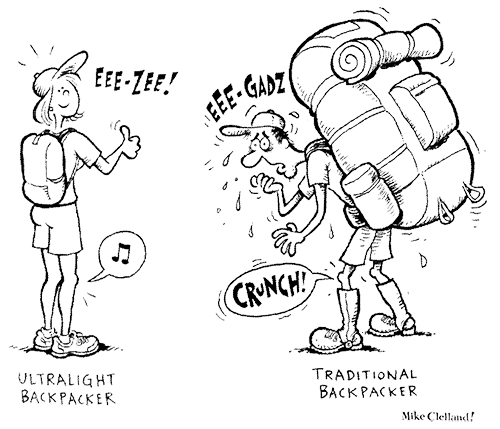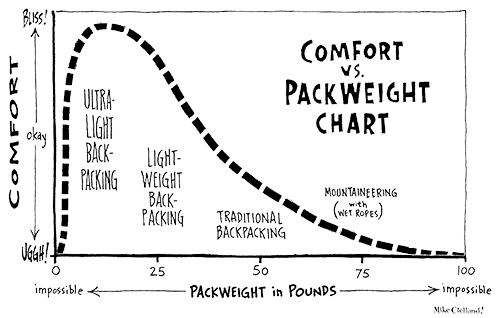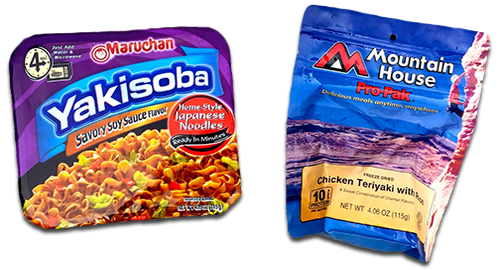The Very Key to Backpacking Joy
Suitable for Experienced Backpackers
This advice is for experienced backpackers only. “Experienced” in this sense means “middle aged or older and still using the traditional gear you’ve hiked in for decades.” If you’re like me, you took up backpacking many years ago and maybe don’t do it as much now. When you do sling on that pack, it feels heavier. And you don’t climb as rapidly or as easily anymore. Going downhill kills the knees. But you have good gear. Lots of it. Gear you acquired over years of getting enough equipment to be prepared for any eventuality. Gear that takes awhile to set up into a camp, but makes for a very comfortable camp once it’s arranged.
Frankly, you need to stop using that gear, and lighten up. That’s the key. Make a transition from traditional backpacking to lightweight backpacking. If you have spent enough time in the backcountry, you’ll be able to figure out how to do that without leaving yourself dangerously exposed on the trail or uncomfortable in camp.
Don’t Be Prepared
“Be Prepared” is a fine motto, and generally a good idea. But not for experienced backpackers. At least, not in the sense of carrying a camp chair, and camp slippers, and specialized repair kits for each item in your pack, and a big multitool, and an OB kit in your first aid bag just in case you run into someone in labor on the trail, and so on. Then it’s just overkill, baggage that weighs you down, overpreparation instead of preparation. You probably came to this web page from the Hiking Timpanogos Safely web page, which emphasizes being prepared, so there’s an irony here, but bear with me.
For some time now, ultralight backpacking fanatics have been chanting the merits of cutting back to the bare essentials. Traditional backpackers have ignored them, in part because it seems they sacrifice safety in order to cut weight. But think about that. Being heavy weighs you down. How safe are you when you’re so tired you aren’t thinking clearly? How safe are you when you’re stumbling? How safe are you when you’re at increased risk of a debilitating ankle sprain in the backcountry, or a heart attack, or a knee injury while working your way down a steep section of trail? If going light lets you think clearly and stay agile on your feet, you have just increased your safety, or at least traded one kind of risk for another while getting considerable hiking comfort in the bargain. By going light you can also go farther, go faster, see more, and enjoy more, with increased vigor. Sounds almost like having an IV of snake oil, doesn’t it? But it really is worth a try. So don’t be prepared. Or more properly, don’t be overprepared. Young pups can carry the kitchen sink; you don’t have to. Take only what you are likely to actually need, not what you might merely want. Rely more on your experience and wisdom, and less on your muscles and joints.
Free your knees, free your mind!
The Ultralight Approach, Gateway to Lightweight Backpacking


There on the right is some information from Mike Clelland’s book Ultralight Backpackin’ Tips, which pretty much says it all (he also illustrated the classic backpacking book Allen & Mike’s Really Cool Backpackin’ Book). Buy the book, or check it out at the library. I’m not advocating going full bore ultralight just like that. But there’s seldom any sense to carrying forty some pounds of pack weight just because everyone did so twenty or thirty years ago, and it isn’t hard to go lightweight. Just carry fewer things. And start switching out heavy for light. Use the careful scrutiny of the ultralight approach as a tool to get your pack weight into lightweight range.
The key to cutting weight is to get out your kitchen scale and weigh every single bit of gear you own, and record the weights, preferably on a spreadsheet. I can pick cotton underwear or nylon underwear out of my drawer. I now know that one kind weighs half of what the other weighs, so I know which to pick. I can buy a bottle of water from the grocery store and save the bottle. The bottle weighs one ounce. Now I’ve saved a third of a pound by leaving my thick plastic backpacker’s water bottle at home. Chlorine dioxide tablets weigh a lot less than a water filter. Do I need to carry an entire spray can of bug repellent? No, a couple of DEET wipes will do, and will weigh a fraction of an ounce instead of a few ounces. When I keep doing this with every item I take into the backcountry, and especially when I leave behind what I may want but don’t need (iPad, multiple pots, etc.), those weight savings add up. Admittedly, the heavy items—backpack, tent, and sleeping bag and pad—can be expensive to replace with lighter gear. But by saving money over time, or making your own equipment, you can eventually get much lighter alternatives to your existing gear.
How much do you skimp on safety and comfort by going lightweight or ultralight? I usually don’t need my old 112.6 ounce backpack, or my 111.9 ounce sleeping bag and pad, or my 143.7 ounce tent and ground cloth to be safe and comfortable. They’re bombproof and I like them in camp. But I don’t like carrying them often anymore. Lightweight replacements—not even rabidly ultralight gear but just lightweight versions of all the above—add up to about 135.7 ounces. That’s eight and a half pounds, and that’s pretty comfortable to carry, even adding food, water, bad weather clothing, and a few other things I need to be safe. Admittedly, the lighter gear isn’t as durable as what it’s replacing, and the down sleeping bag needs to be kept somewhat dry, and the quasi-insulated air mattress kept free from punctures, and the pack and the tent kept away from especially scratchy brush, but this gear is good enough for the conditions I’ll take them into, and I’m more durable for using them. If I’m expecting more robust environmental challenges, I can always pack my old beefier gear instead. Ultralight backpackers like to point out that their packs are so light and comfortable, they don’t even require the weight of a hip belt! Of course, comfort in this sense refers mostly to comfort while hiking. Comfort in camp requires carrying more gear than ultralight zealots prefer, but not as much gear as one might think, and there are many lightweight options.
So go do an experiment. Hike a short way with forty-five pounds of pack weight. Then hike the same distance with a fifteen pound pack. See which you like best. Then start using the ultralight approach as a guide to getting from a traditional backpacking weight down to a much lighter load. That’ll get you back into the mountains and deserts where you belong.
 Just one added tidbit here. One of the meals shown on the left weighs less than the other, but has more calories so it provides more energy, and only costs a tenth as much, while being easily repackagable into a resealable bag (it doesn’t have to be microwaved, as it can be made by mixing with boiling water). Hint: it’s not the expensive freeze dried dinner, it’s the yakisoba noodles. Replacing major gear with lightweight gear may cost some money, but not everything that some people bill as a lightweight or ultralight essential, is essential; often simple and inexpensive things are best. If you’re determined to use freeze dried, and if it’s one of those bulky, air filled packages, consider pinpricking a hole near the top of it and carefully squeezing the air out, then taping over the hole, so the package doesn’t take up as much room in the pack. Calories needn’t be that expensive, though, they just need to be plentiful while hiking. (But not at other times. Avoiding excess weight under your skin makes your heart and joints happy when you’re hiking.) The ultralight ethos treads an interesting path between an ascetic minimalism on the one hand, and on the other the conspicuous consumption inherent in buying the latest creations of boutique manufacturers using high tech fabrics so new and unique that you won’t find them in stores. Eschew the extremes; ultralight is an approach, not a religion.
Just one added tidbit here. One of the meals shown on the left weighs less than the other, but has more calories so it provides more energy, and only costs a tenth as much, while being easily repackagable into a resealable bag (it doesn’t have to be microwaved, as it can be made by mixing with boiling water). Hint: it’s not the expensive freeze dried dinner, it’s the yakisoba noodles. Replacing major gear with lightweight gear may cost some money, but not everything that some people bill as a lightweight or ultralight essential, is essential; often simple and inexpensive things are best. If you’re determined to use freeze dried, and if it’s one of those bulky, air filled packages, consider pinpricking a hole near the top of it and carefully squeezing the air out, then taping over the hole, so the package doesn’t take up as much room in the pack. Calories needn’t be that expensive, though, they just need to be plentiful while hiking. (But not at other times. Avoiding excess weight under your skin makes your heart and joints happy when you’re hiking.) The ultralight ethos treads an interesting path between an ascetic minimalism on the one hand, and on the other the conspicuous consumption inherent in buying the latest creations of boutique manufacturers using high tech fabrics so new and unique that you won’t find them in stores. Eschew the extremes; ultralight is an approach, not a religion.
